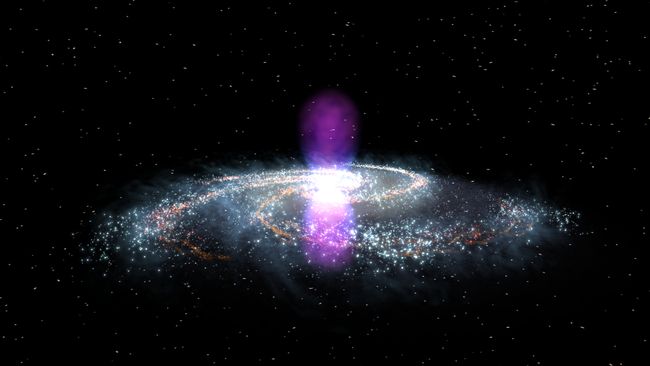Post by Origanalist on Oct 8, 2019 7:51:11 GMT -8
Early Earthlings May Have Watched the Galaxy's Center Explode 3.5 Million Years Ago
The center of the Milky Way exploded 3.5 million years ago —and may explode again very soon.

The Fermi bubbles, illustrated in gamma-ray light here, tower over the Milky Way and speak to a gargantuan cosmic explosion from the center of our galaxy. New research attempts to pinpoint that explosion's date.(Image: © NASA Goddard)
At the center of our galaxy is a supermassive black hole which, apparently, likes to blow bubbles.
Ballooning out of both poles of the galactic center, two gargantuan orbs of gas stretch into space for 25,000 light-years apiece (roughly the same as the distance between Earth and the center of the Milky Way), though it's visible only in ultra powerful X-ray and gamma-ray light. Scientists call these cosmic gas orbs the Fermi bubbles and know that they're a few million years old. What caused this bout of galactic indigestion, however, is one of our galaxy's biggest mysteries.
Now, by looking for evidence of this violent bubble-blowing event in the scorched clouds of gas in one of the Milky Way's satellite galaxies, researchers have reconstructed a plausible explanation for the bubbles' birth. According to a study to be published Oct. 8 in the preprint journal arXiv.org, the Fermi bubbles were created by an epic flare of hot, nuclear energy that shot out of the galaxy's poles roughly 3.5 million years ago, beaming into space for hundreds of thousands of light-years.
The effect would have been sort of "like a lighthouse beam" that shone out of our galaxy's middle for 300,000 years, lead study author Joss Bland-Hawthorn, director of the Sydney Institute for Astronomy at the University of Sydney, told Live Science in an email. And, given the recent (cosmically speaking) date of the explosion that Bland-Hawthorn and his team calculated, the blast may even have been visible to early humans.
"It's an amazing thought that, when cave people walked the Earth, if they'd looked off in the direction of the galactic center, they'd have seen some kind of giant ball of heated gas," Bland-Hawthorn said in a video accompanying the study.
continued.. www.livescience.com/seyfert-flare-blew-fermi-bubbles.html
The center of the Milky Way exploded 3.5 million years ago —and may explode again very soon.

The Fermi bubbles, illustrated in gamma-ray light here, tower over the Milky Way and speak to a gargantuan cosmic explosion from the center of our galaxy. New research attempts to pinpoint that explosion's date.(Image: © NASA Goddard)
At the center of our galaxy is a supermassive black hole which, apparently, likes to blow bubbles.
Ballooning out of both poles of the galactic center, two gargantuan orbs of gas stretch into space for 25,000 light-years apiece (roughly the same as the distance between Earth and the center of the Milky Way), though it's visible only in ultra powerful X-ray and gamma-ray light. Scientists call these cosmic gas orbs the Fermi bubbles and know that they're a few million years old. What caused this bout of galactic indigestion, however, is one of our galaxy's biggest mysteries.
Now, by looking for evidence of this violent bubble-blowing event in the scorched clouds of gas in one of the Milky Way's satellite galaxies, researchers have reconstructed a plausible explanation for the bubbles' birth. According to a study to be published Oct. 8 in the preprint journal arXiv.org, the Fermi bubbles were created by an epic flare of hot, nuclear energy that shot out of the galaxy's poles roughly 3.5 million years ago, beaming into space for hundreds of thousands of light-years.
The effect would have been sort of "like a lighthouse beam" that shone out of our galaxy's middle for 300,000 years, lead study author Joss Bland-Hawthorn, director of the Sydney Institute for Astronomy at the University of Sydney, told Live Science in an email. And, given the recent (cosmically speaking) date of the explosion that Bland-Hawthorn and his team calculated, the blast may even have been visible to early humans.
"It's an amazing thought that, when cave people walked the Earth, if they'd looked off in the direction of the galactic center, they'd have seen some kind of giant ball of heated gas," Bland-Hawthorn said in a video accompanying the study.
continued.. www.livescience.com/seyfert-flare-blew-fermi-bubbles.html

